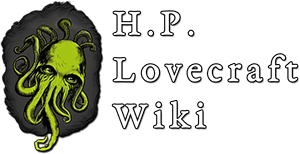![]()
![]() "From Beyond" is a short story by writer H. P. Lovecraft. It was written in 1920 and was first published in The Fantasy Fan in June 1934 (Vol. 1, No. 10).
"From Beyond" is a short story by writer H. P. Lovecraft. It was written in 1920 and was first published in The Fantasy Fan in June 1934 (Vol. 1, No. 10).
Synopsis[]
The story is told from the first person perspective of an unnamed narrator and details his experiences with a scientist named Crawford Tillinghast. Tillinghast creates an electronic device that emits a resonance wave, which stimulates an affected person’s pineal gland, thereby allowing them to perceive planes of existence outside the scope of mundane reality.
Sharing the experience with Tillinghast, the narrator becomes cognizant of a translucent, alien environment that overlaps our own recognized reality. From this perspective, he witnesses hordes of strange and horrific creatures that defy description. Tillinghast reveals that he has used his machine to transport his house servants into the overlapping plane of reality. He also reveals that the effect works both ways, and allows the denizens of the alternate dimension to perceive humans. Tillinghast's servants were attacked and killed by one such entity, and Tillinghast informs the narrator that it is right behind him. Terrified beyond measure, the narrator picks up a gun and shoots it at the machine, destroying it. Tillinghast dies immediately thereafter as a result of a stroke. The police investigate the scene and it is placed on record that Tillinghast murdered the servants in spite of their remains never being found.
Characters[]
Crawford Tillinghast[]
- Main article: Crawford Tillinghast
Reaction[]

Crawford Tillinghast by Hrairoo
The book Science-Fiction: The Early Years describes the concepts of "From Beyond" as "very interesting, despite stiff, immature writing".[1] S. T. Joshi judges it "unlikely that 'From Beyond'...will ever be regarded as one of Lovecraft's better tales", due to "its slipshod style, melodramatic excess and general triteness of plot".[2]
Joshi also considers Crawford Tillinghast's references to the pineal gland to be a joke at the expense of René Descartes, who proposed that this gland was the point of mediation between the material body and the immaterial soul.[3] Despite Joshi's somewhat eccentric interpretation, a more likely explanation is the influences of Theosophy and fringe Egyptology. The Third Eye or Prophetic Eye is located ...in the pineal gland.
Connections[]
- Joshi points out that "From Beyond"'s theme of "a reality beyond that revealed to us by the senses, or that which we experience in everyday life", is continued in later Lovecraft tales, such as "The Shunned House" (1924), "The Colour Out of Space" (1927), "The Dreams in the Witch House" and others.[4]
- A narrator says that "scientific study and reflection had taught us that the known universe of three dimensions embraces the merest fraction of the whole cosmos of substance and energy." (HPL: "The Shunned House")
Adaptations[]
- "From Beyond" was adapted into a 1986 film of the same name by horror director Stuart Gordon. Gordon has also written or directed such Lovecraft adaptations as Re-Animator (1985), Dagon (2001), and an episode of Masters of Horror (2005) entitled "Dreams in the Witch House".
- The short story was also the inspiration for the 2013 horror film Banshee Chapter, which loosely adapts the short story and 1986 Gordon film.
- Lovecraft Anthology: Volume II (2012): the story was adapted for the comic book format by David Camus and features artwork by Nicolas Fructus.
In popular culture[]
- American stoner doom metal band and Lovecraft-devotees Sleep included a song called "From Beyond" on their classic 1992 album Sleep's Holy Mountain.
- Charles Stross' novel The Jennifer Morgue features an electronic device known as a "Tillinghast resonator", which allows the user to see otherwise invisible entities.
- American death metal band Massacre released a largely Lovecraft-themed album called From Beyond in 1991.
- The video game Psi-Ops: The Mindgate Conspiracy features "Aura Beasts" that are seen using one of the psychic powers the main protagonist develops called "Aura View". This ability parallels the effects Crawford Tillinghast's device has on the characters in "From Beyond", who perceive creatures from another dimension as a result of using the device.
- In the Stargate SG-1 episode "Sight Unseen", an alien device is accidentally activated that allows members of SG-1 to see, but not interact with, strange insect-like creatures who inhabit a dimension parallel to our own. Though originally confined to the Cheyenne Mountain Complex, the phenomenon of this "second sight" is also spread by touch. It quickly spreads to nearby populations, mostly by way of a "sight-infected" conspiracy theorist who stumbles upon a real government conspiracy concerning aliens and the SG-1. Parts of Colorado and Wyoming are "quarantined" until the process can be reversed. Hallucinogenic gas is used as cover-up story.
- Death metal band Ripping Corpse's song "Beyond Humanity" is clearly directly inspired by the Lovecraft story and the Gordon film.
- Dark ambient and Halloween]-themed duo Nox Arcana based their 2009 album Blackthorn Asylum on this story, with some twists of their own.
- American heavy metal band Manilla Road adapted the story to a song of the same name featured in their 1990 album The Courts of Chaos.
- Dimethyltryptamine instead of Ultraviolet. At one point Lovecraft's short story is explicitly mentioned.
- The Star Trek: The Next Generation episode "Phantasms" features inter-phasic parasites, undetectable under normal conditions, that feed off of cellular matter, and are perceived by Data as surrealistic objects during his dream program. Individuals experiencing elements of the world beyond our own through dreams and visions is a common theme in Lovecraftian literature.
Notes[]
- ↑ E. F. Bleiler and Richard Bleiler. Science-Fiction: The Early Years. Kent State University Press, 1990. (p.454). ISBN 9780873384162.
- ↑ Joshi, p. 18.
- ↑ Joshi, pp. 18–19.
- ↑ Joshi, pp. 21–22.
External links[]
- Publication history from The H. P. Lovecraft Archive
